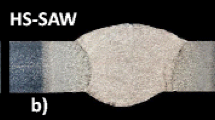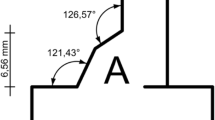Abstract
New lightweight structures in shipbuilding aim at plate thicknesses below 5 mm in combination with welding processes characterised by low heat-input, i.e. laser and laser-hybrid welding. In the European research project BESST—“Breakthrough in European Ship and Ship Building Technologies”, an extensive fatigue test programme was carried out for butt- and fillet-welded specimens, which were manufactured by conventional arc, laser and laser-hybrid welding processes. Plate thicknesses down to 3–4 mm were included. The test programme covered also the different production quality including various levels of misalignments. Utilising the extensive fatigue test results, the present paper aims to identify the factors that influence fatigue strength based on the structural stress approach. Secondary bending stresses due to misalignments are directly considered in the structural stress. Different methods of stress determination are applied, such as the through-thickness linearization, surface stress extrapolation, Haibach’s approach and Xiao and Yamada’s approach. Special attention is given to quality aspects such as undercuts. Based on the results, the suitability of the different structural stress approaches to the fatigue assessment of thin-plated joints in particular are discussed with special consideration of the various welding processes and quality aspects.














Similar content being viewed by others
References
Eggert L, Fricke W, Paetzold H (2012) Fatigue strength of thin-plated block joints with typical shipbuilding imperfections. Weld World 56(11/12):119–128
Lillemäe I, Lammi H, Molter L, Remes H (2012) Fatigue strength of welded butt joints in thin and slender specimens. Int J Fatigue 44:98–106
ISO 5817 (2003) Welding—fusion-welded joints in steel, nickel, titanium and their alloys (beam welding excluded)—quality levels for imperfections
ISO 13919–1(1996) Welding—electron and laser-beam welded joints—guidance on quality levels for imperfections—part 1: steel
Radaj D, Sonsino CM, Fricke W (2006) Fatigue assessment of welded joints by local approaches. Woodhead Publ, Cambridge
Hobbacher A (2009) Recommendations for fatigue design of welded joints and components. Welding Research Council Bulletin 520, New York
Fricke W (2012) IIW recommendations for the fatigue assessment of welded structures by notch stress analysis. Woodhead Publ, Cambridge
Niemi E, Fricke W, Maddox SJ (2006) Fatigue analysis of welded components—designer’s guide to the hot-spot stress approach. Woodhead Publ, Cambridge
Lotsberg I, Landet E (2005) Fatigue capacity of side longitudinals in floating structures. Mar Struct 18(1):25–42
Haibach E (1968) Die Schwingfestigkeit von Schweißverbindungen aus der Sicht einer örtlichen Beanspruchungsmessung (The fatigue strength of welded joints considered on the basis of a local stress measurement), LBF-Bericht FB-77, Darmstadt, Fraunhofer-Inst. für Betriebsfestigkeit
Xiao ZG, Yamada K (2004) A method of determining geometric stress for fatigue strength evaluation of steel welded joints. Int J Fatigue 26:1277–1293
Poutiainen I, Tanskanen P, Marquis G (2004) Finite element methods for structural hot spot stress determination—a comparison of procedures. Int J Fatigue 26:1147–1157
Fricke W, Kahl A (2005) Comparison of different structural stress approaches for fatigue assessment of welded ship structures. Mar Struct 18:473–488
Fricke W, Bollero A, Chirica I, Garbatov Y, Jancart F, Kahl A, Remes H, Rizzo CM, von Selle H, Urban A, Wei L (2008) Round robin study on structural hot-spot and effective notch stress analysis. Ships Ocean Struct 3:335–345
Fricke W, Feltz O (2013) Consideration of influence factors between small-scale specimens and large components on the fatigue strength of thin-plated block joints in shipbuilding. Fatigue Fract Eng Mater Struct 36(12):1223–1231
Fricke W, Remes H, Feltz O, Lillemäe I, Tchuindjang D, Reinert T, Nevierov A, Sichermann W, Brinkmann M, Kontkanen T, Bohlmann B, Molter L (2013) Fatigue strength of laser-welded thin plate ship structures based on nominal and structural hot-spot stress approach. Proc. of 4th Int. Conf. on Marine Structures (MARSTRUCT’2013). Guedes Soares C, Romanoff J (Eds). Taylor & Francis, London. pp 249–254
Acknowledgments
The fatigue tests leading to the presented results have received funding from the European Community’s Seventh Framework Programme (FP7/2007–2013) under grant agreement n° 233980. The analysis of the fatigue test results is funded also by the Finnish Academy of Science under grant agreement n° 261286. All the financial support is gratefully appreciated.
Author information
Authors and Affiliations
Corresponding author
Additional information
Doc. IIW-2485, recommended for publication by Commission XIII “Fatigue of Welded Components and Structures”.
Rights and permissions
About this article
Cite this article
Remes, H., Fricke, W. Influencing factors on fatigue strength of welded thin plates based on structural stress assessment. Weld World 58, 915–923 (2014). https://doi.org/10.1007/s40194-014-0170-7
Received:
Accepted:
Published:
Issue Date:
DOI: https://doi.org/10.1007/s40194-014-0170-7




